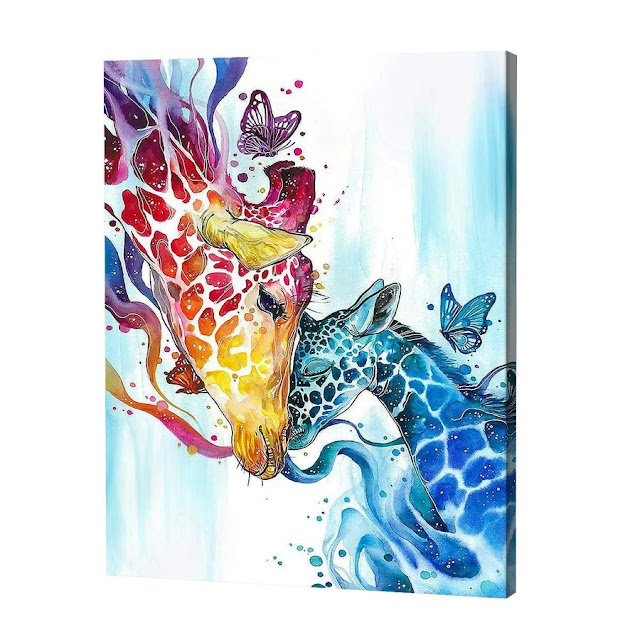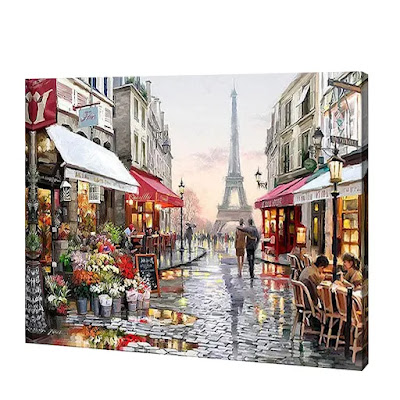What to Do When You Get Stuck on a Landscape Paint by Numbers Project
Landscape Paint by Numbers is a fantastic way to
unwind and create beautiful art, even if you don’t consider yourself an artist.
However, like any creative project, it’s easy to hit a wall and feel stuck or
frustrated. Whether you’re struggling with blending colors, navigating intricate
details, or simply losing motivation, getting stuck can take the joy out of the
experience. Fortunately, there are several strategies to help you overcome
these challenges and get back on track. Here’s what to do when you get stuck on
a landscape paint by numbers project.
1. Take a Step Back and Assess the Situation
When you find yourself struggling with your Paint by Numbers project, the first
thing to do is take a step back and look at the bigger picture. Assess what
part of the painting is causing difficulty. Is it a particular section that’s
too detailed? Are the colors not blending as you’d like? Are you feeling
overwhelmed by the sheer amount of work left to do? Identifying the specific
issue can help you find a targeted solution.
Sometimes, taking a short break from your painting allows
you to return with fresh eyes and a clearer perspective. This pause can help
you notice areas that need adjustments or provide new ideas on how to approach
the problem. Use this time to relax, refresh, and come back to your painting
with renewed energy.
2. Break the Painting Down into Smaller Tasks
One common reason for feeling stuck is being overwhelmed by
the scale of the painting, especially with larger Landscape
Paint by Numbers projects. Breaking down the painting into smaller,
more manageable tasks can help. Instead of thinking about completing the entire
canvas, focus on just one small section at a time.
Set mini-goals, such as finishing a specific color or
completing one part of the landscape, like the sky or a tree. This approach
makes the project feel less daunting and allows you to celebrate small
victories along the way. Completing small sections gradually builds momentum
and motivation to keep going.
3. Experiment with Color Blending and Shading
One of the joys of Landscape Paint by Numbers is the
opportunity to play with colors, but it can also be a source of frustration if
blending doesn’t go as planned. If you’re struggling with harsh lines between
colors or creating depth, try experimenting with blending techniques. Use a
slightly damp brush to soften the edges where two colors meet, creating a
smoother transition.
For more advanced shading, mix a bit of the adjacent colors
on your palette before applying them to the canvas. This technique helps create
subtle gradients that enhance the realism of your landscape. Don’t be afraid to
deviate slightly from the paint-by-numbers guide to achieve the desired effect;
blending and shading can add a professional touch to your artwork.
4. Try Different Brushes for Better Control
If you’re finding certain sections difficult, the problem
might be as simple as using the wrong brush. Intricate details in Paint by
Numbers often require precise brushwork, and switching to a smaller or
differently shaped brush can give you the control you need. For example, a
fine-tipped round brush is perfect for tiny details, while a flat brush works
well for broader strokes.
Experiment with different brushes to see which ones feel
most comfortable and effective for various parts of the painting. Sometimes,
using a new tool can reignite your enthusiasm and make challenging areas more
manageable.
5. Use Reference Images for Guidance
Landscape scenes can be complex, with layers of elements
like trees, water, and skies. If you’re unsure how to proceed, use reference
images of similar landscapes for guidance. Look at photos or paintings of
similar scenes to understand how light interacts with different elements, how
colors blend naturally, and where shadows and highlights should be placed.
Reference images can inspire you and provide visual clues on
how to tackle tricky sections. They can also help you feel more confident when
adding your personal touches, making the painting process more intuitive and
less stressful.
6. Take Breaks and Pace Yourself
Painting for long periods can be mentally and physically
draining, especially if you’re focused on fine details. If you’re feeling
stuck, it’s okay to take breaks and pace yourself. Stepping away for a few
minutes—or even a few days—can help prevent burnout and keep the activity
enjoyable.
During your break, do something relaxing or inspiring, like
taking a walk in nature or listening to music. Returning to your painting with
a fresh mindset can help you see it differently and provide the motivation you
need to continue. Remember, Paint by Numbers is meant to be a relaxing
and fun experience, so there’s no need to rush.
7. Don’t Be Afraid to Improvise
If you’re stuck because a certain area doesn’t look right or
the colors don’t seem to match perfectly, don’t hesitate to improvise. Paint
by Numbers is a guide, not a strict set of rules. Feel free to adjust
colors, add extra details, or simplify complex sections to suit your
preferences. Adding a personal touch can make the painting more enjoyable and
uniquely yours.
For example, if you’re not satisfied with how the sky looks,
add some extra clouds or a gradient of colors. If the trees seem too uniform,
vary the shades of green or add textured brushstrokes to give them more
character. Embracing creativity can transform your painting from a structured
activity into an expressive art piece.
8. Rotate the Canvas for a New Perspective
Sometimes, simply rotating your canvas can help you see your
work from a new angle. Painting in the same position for too long can lead to
tunnel vision, where mistakes or areas that need improvement go unnoticed. By
rotating the canvas, you can spot inconsistencies or get a fresh perspective on
how to approach challenging sections.
This simple trick can make it easier to work on details that
were previously hard to reach and help you visualize the composition
differently. It’s an easy way to refresh your approach and keep the creative
process moving forward.
9. Ask for Feedback or Join Online Communities
If you’re really stuck and can’t seem to find a solution,
seek feedback from others. Show your progress to friends or family who might
offer a fresh perspective or helpful suggestions. You can also join online
communities of Paint by Numbers enthusiasts who share tips, advice, and
encouragement.
These communities are great for finding inspiration and
learning from others who have faced similar challenges. Sometimes, hearing how
someone else overcame a similar hurdle can provide the exact motivation you
need to push through.
10. Celebrate Your Progress, Not Just the Finish Line
One of the best ways to stay motivated and avoid getting
stuck is to celebrate your progress along the way. Landscape Paint by
Numbers is not just about the finished painting; it’s about enjoying the
process. Take pride in each section you complete, and remember that every
brushstroke contributes to your overall masterpiece.
Keep your painting journey fun by documenting your progress
with photos, sharing your work with friends, or simply stepping back to admire
what you’ve accomplished so far. Acknowledging these small wins can help you
stay motivated and enjoy the experience, even when things don’t go perfectly.
Final Thoughts
Getting stuck on a Landscape Paint by Numbers project
is a common challenge, but it doesn’t have to derail your enjoyment. By taking
breaks, experimenting with new techniques, and keeping a positive mindset, you
can overcome obstacles and continue creating beautiful artwork. Remember, the
goal is to relax, have fun, and let your creativity flow. Each step of the
process, no matter how challenging, is an opportunity to learn and grow as an
artist. So take a deep breath, pick up your brush, and keep painting—your
masterpiece is waiting to be finished!




Comments
Post a Comment